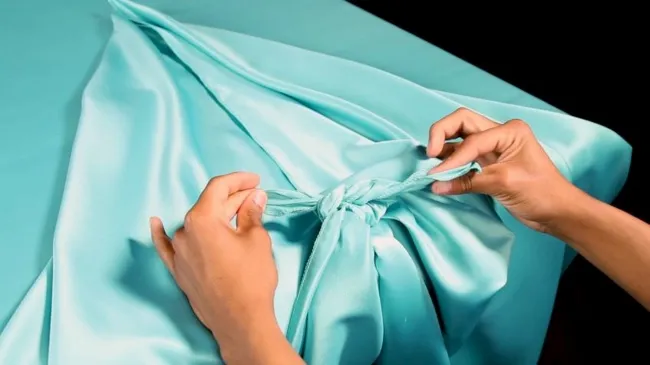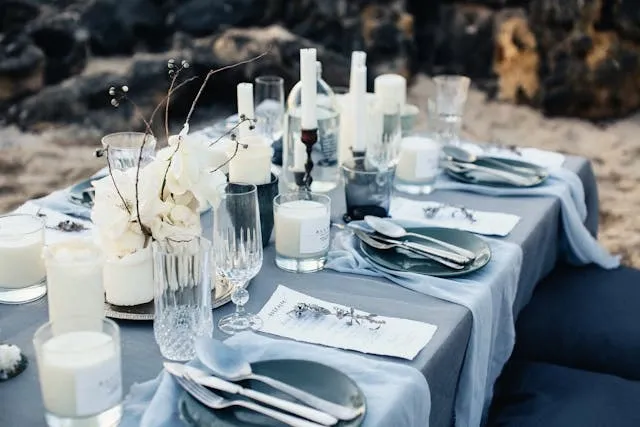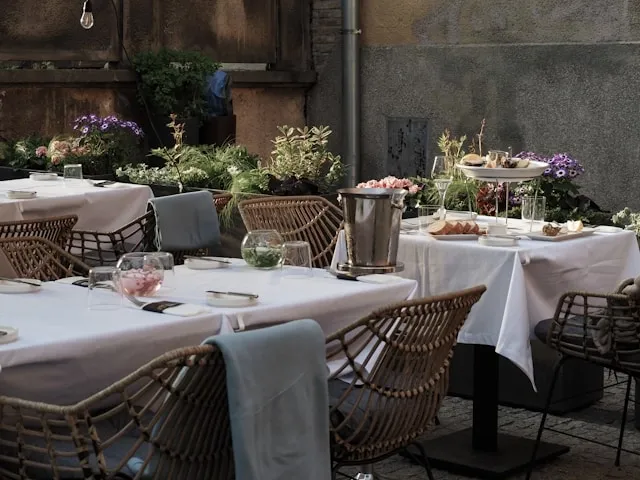How To Tie Tablecloth Corners And Secure Them Effectively
Securing a tablecloth in place can be challenging, particularly for outdoor gatherings where wind and movement are common issues. In this post, we look at various techniques for how to tie tablecloth corners effectively, ensuring a neat and polished appearance. From simple knots to robust clips and weights, these tips will help you maintain your stylish table settings, no matter the occasion. Read on to learn all you need to know.

Key Takeaways
- You can tie a tablecloth at the corners or the ends to secure it in place and create a neat appearance.
- For outdoor conditions, you can use things like tablecloth clips and weights to prevent tablecloth displacement in the wind.
- Remember that different tablecloth fabrics may require different methods to secure them in place.
- We supply high-quality custom polyester tablecloths for various occasions that can be secured in place using different methods.
How To Tie Tablecloth Corners
So you've set your tablecloth, complete with runners and placemats, but now you are worried about how to ensure everything stays in place. One simple approach is to learn how to tie tablecloth corners. Here's a step-by-step guide to ensure a neat and secure table setting:
- Smooth the tablecloth: Lay your tablecloth flat on the table, and ensure it is evenly distributed.
- Gather the corners: At each corner, gather excess fabric and pull it tight.
- Form a knot: Cross the gathered fabric and loop it through to create a simple knot.
- Secure the knot: Tighten your knot close to the table edge to prevent slipping.
People choose different methods for how to tie a tablecloth. Creating those basic knots in the corners is effective for most tablecloths and provides a casual look. Some people choose to use fabric ties or ribbons to secure corners, adding a decorative touch.
To do this job you will need:
- A tablecloth
- Ribbon or ties (optional)
- Clothespins or clips (for extra security)

How Do You Corner A Tablecloth?
There are several approaches to cornering a tablecloth. Some people opt for the basic tuck and fold, whereby you lay the tablecloth flat, fold in the corners, and tuck excess fabric underneath the tablecloth for a seamless look. Tying knots, as in the previous section, is another good approach, while using clips or weights at the corners can be great for securing the tablecloth in place.
There are some common errors when doing this work. Here are some tips to avoid these mistakes:
- Make sure the tablecloth is centered and evenly distributed before you secure the corners.
- Don't pull the tablecloth too tight when knotting - this can distort the tablecloth's shape.
- If you are outside in windy conditions, use clips or weights to prevent the tablecloth from shifting in the wind.
With these techniques and tips, you can have peace of mind that your custom fitted table covers will stay in place throughout your event.
How To Tie Tablecloth Ends?
In exploring how to tie a tablecloth, learning about tying tablecloth ends gives you a different approach to achieve a decorative look whilst ensuring your tablecloth stays in place. Here are some different techniques to achieve this:
- Simple knot: Tie a simple knot by pulling the excess fabric at the ends of the tablecloth and forming a loose, simple knot. Don't tie it too tight or you will wrinkle the tablecloth.
- Bow tie: Connect the fabric at each end of the tablecloth and form two loops, similar to tying a shoelace. Cross the loops and pull through to tie a bow.
- Twist and tuck: Twist the excess fabric at the ends several times. Then secure the twisted fabric under the tablecloth edge.
When applying these methods you will need to ensure that the tablecloth is evenly distributed before you tie the ends. It may be helpful to secure your knots in place with clips or pins for a tighter hold. Don't tie your knot too tight as this may result in fabric damage.
How To Tie A Long Tablecloth?
It can be challenging to tie a long tablecloth, but you can achieve a neat and appealing table setting when armed with the right techniques. Begin by ensuring the tablecloth is evenly distributed all around the table. For longer covers, we suggest the twist and tuck method, whereby you gather excess fabric at the corners, twist tightly, and tuck under the tablecloth edge.
Doing this prevents tripping and helps keep the cloth secure. For a decorative touch, tie a simple knot or bow at each corner. Clips or tablecloth weights are your friends for holding the fabric in place. With these solutions, your long table cloths will look elegant and stay in position.
Enjoy cocktail table covers designed for your purpose
Our custom cocktail tablecloths can be personalized to match your event or aesthetic, and you can tie the corners to create the perfect elegant look for any occasion.
How To Secure And Hold A Tablecloth Outside?
When exploring how to secure a table cover outside, your main challenges are the wind, uneven surfaces, and high traffic. We suggest that you start by using tablecloth clips. These are inexpensive accessories that are easy to use and effective in holding the fabric down on all sides. Weights are another great option, and you can purchase decorative tablecloth weights or use items like heavy utensils or small stones tied to the tablecloth corners.
For added security, consider adding a non-slip table pad underneath the tablecloth. This helps protect against sliding and provides a stable base. If you have a fitted tablecloth, make sure it is snug around the table edges to resist shifting. You could even add elastic bands or bungee cords to hold the tablecloth tightly in place, as well as learning how to tie tablecloth corners.
Apply a combination of these methods to secure your tablecloth outdoors.

What To Do If Your Tablecloth Is Getting Blown Away Outside
If your tablecloth keeps shifting in the wind outside, there are several steps you can take to secure it against this problem. Tablecloth clips, as mentioned in the previous section, will hold your fabric in place firmly. They are especially useful for picnic tables and outdoor dining. Tablecloth weights can also be attached to the corners to prevent the clot from lifting. Decorative weights can be shaped like fruits or animals to add a touch of charm in addition to the practical benefits.
To further boost security, apply a non-slip table pad underneath the tablecloth. You could also add a heavy, decorative centerpiece on your table setting to anchor the tablecloth in position. Elastic bands or bungee cords can be secured around the table legs for an even more robust solution. Finally, double-sided tape can be applied along the table edges to hold the tablecloth in place without damaging the surface.
A combination of these solutions is effective to keep a tablecloth from blowing away in the wind.
Ways Of Keeping A Tablecloth From Sliding From The Table Outdoors
Tablecloths often slide on outdoor table settings due to the wind, uneven surfaces, and movement. To keep table covers from sliding, start by using non-slip tablecloth liners or pads underneath the tablecloth. These provide extra grip and stability, and could be used in combination with tablecloth clips to securely fasten your tablecloth to the table edges.
Learning how to tie tablecloth corners with strings or elastic bands could secure the table cover to the legs to help keep it in place. You can also add weights to tablecloth corners or along the edges for robust anchoring.
Finally, consider using heavy-duty fabrics like polyester or vinyl as they are less prone to slipping in the wind. Combining these methods may be the most effective solution to prevent your tablecloth from sliding outdoors.
Methods Of Keeping A Plastic Tablecloth Secured Outdoors
Unlike fabric ones, custom plastic tablecloths can be more prone to sliding and blowing away as they are lightweight and slippery. To secure them outdoors, you should consider the following specific techniques:
- Tablecloth clips: These are very effective for plastic tablecloths, clamping onto table edges to provide a firm hold against wind and movement.
- Double-sided tape: Apply strips of this along the table surface before laying the plastic tablecloth on top to prevent slipping.
- Elastic tablecloths: Choose fitted plastic tablecloths with elastic edges to fit snugly around the table to reduce the risk of displacement.
- Weights: Attach weights around the corners and edges of your tablecloth. Clip-on or sewn-in weights are effective.
- Tiedowns: Bungee cords or ropes can be used to secure your tablecloth, tied through grommets or around table legs.
Alternatively, you could order custom polyester tablecloths from us for a heavyweight, fitted solution that is more resistant to the wind.
Need an unusual size or shape to cover your cocktail tables?
Our custom size tablecloths can be designed to match your specific needs, and you can incorporate bespoke designs and tie or decorate them however you like.
Order nowHow To Use Table Clamps Or Clips To Secure A Tablecloth
Table clamps and clips or an effective alternative to tying table cloth corners to secure them in place. They are particularly useful outdoors, where wind and movement are a frequent threat. You will find simple, affordable plastic clips, more durable metal clamps that are ideal for thicker tables, or makeshift solutions featuring elastic bands with clips for a more flexible solution.
Here is how to use them:
- Prepare your tablecloths: Lay your tablecloth with even distribution over your table.
- Position the clips: Starting at one end, attach a clip to the table edge to secure in place. Repeat on the opposite side to maintain tension.
- Secure the corners: Attach clips to each corner, pulling the tablecloth tight to prevent it from moving.
- Additional clips: For larger tables, add extra clips along the edges for better security.
Clamps and clips are very effective for keeping tablecloths in place. They are easy to apply and remove, so they are convenient for all types of setups. Choosing the right type of clip or clamp ensures a durable and stable table set up.
How To Use Tablecloth Weights?
Tablecloth weights are practical accessories that help keep tablecloths in place, especially when dining outdoors in windy conditions. They come in several forms, including clamp-on weights that are secured to the table cloth edges, magnetic weights attached to metal surfaces underneath the tablecloth, and clip-on weights that clip onto your tablecloth hem.
To apply tablecloth weights, use the intended attachment method as guided in the product instructions. Plan the weight distribution carefully to ensure even placement around the edges. Always check that the weights are firmly attached to prevent movement when in use.
Tablecloth weights are a helpful tool in windy conditions. They are easy to apply and remove, and suitable for various table sizes. One limitation is that they may not work well on thick or non-metallic tables, and they may be visible under lightweight fabrics.
How To Use Anti-Slip Mats Under Your Tablecloth
Anti-slip mats are useful accessories that prevent table cloths from being displaced, particularly on smooth surfaces like glass or a polished wood table. These mats are typically made from rubber or silicone, which offer grip on smooth surfaces. They create friction between the tablecloth and table, reducing the risk of displacement through movement or wind.
To use an anti-slip mat, make sure the table surface is clean and dry. Lay the anti-slip mat flat on the table, and position your tablecloth over the mat, ensuring it lies flat and centered. Smooth out any wrinkles or folds to achieve a neat appearance.
Using anti-slip mats under your custom printed tablecloths can be effective in preventing sliding and displacement. They are easy to use and reusable. The only downside is that they may not adhere well to very rough or textured surfaces.

How To Use Bungee Cords And Tie Downs?
Using bungee cords and tie-downs is an effective method to secure tablecloths outdoors or in windy conditions, protecting against shifting when the wind picks up.
To use bungee cords, attach one end of the bungee cord to a secure point under the table. Stretch the cord across the tablecloth, and secure to the opposite end underneath the table. Adjust tension as needed to keep the tablecloth tight.
Tie-downs, on the other hand, act as anchor points and often include adjustable straps or clips. Fasten one onto a sturdy anchor point on the table or ground. Pull the strap across the tablecloth, securing the opposite end to another anchor point.
Bungee cords are suitable for moderate wind conditions, and they offer flexibility and quick set-up. Tie-downs allow for adjustable tension, so they may be the superior solution for strong winds and uneven surfaces.
Customize your table cloths with us to get a bespoke solution for your occasion, and use any of the above methods to protect against windy conditions and preserve the pristine appearance of your table settings.
Try a fitted, tailored look for your cocktail tables
With our custom spandex table covers, you can create a bespoke piece that hugs the contours of your table for a sleek, modern look that doesn’t require tying.
Frequently Asked Questions About How To Tie Tablecloth Corners
How To Tie The Corners Of A Tablecloth?
To tie tablecloth corners, gather the excess fabric at the corners of your table and tie it into a simple knot to achieve a tighter fit on the table. This can help protect against displacement.
How To Secure And Hold A Tablecloth Outside?
In outdoor conditions, tying a tablecloth may not be enough to protect against wind. Other solutions include tablecloth clips, weights, anti-slip mats, centerpieces, and using bungee cords or tie-downs.